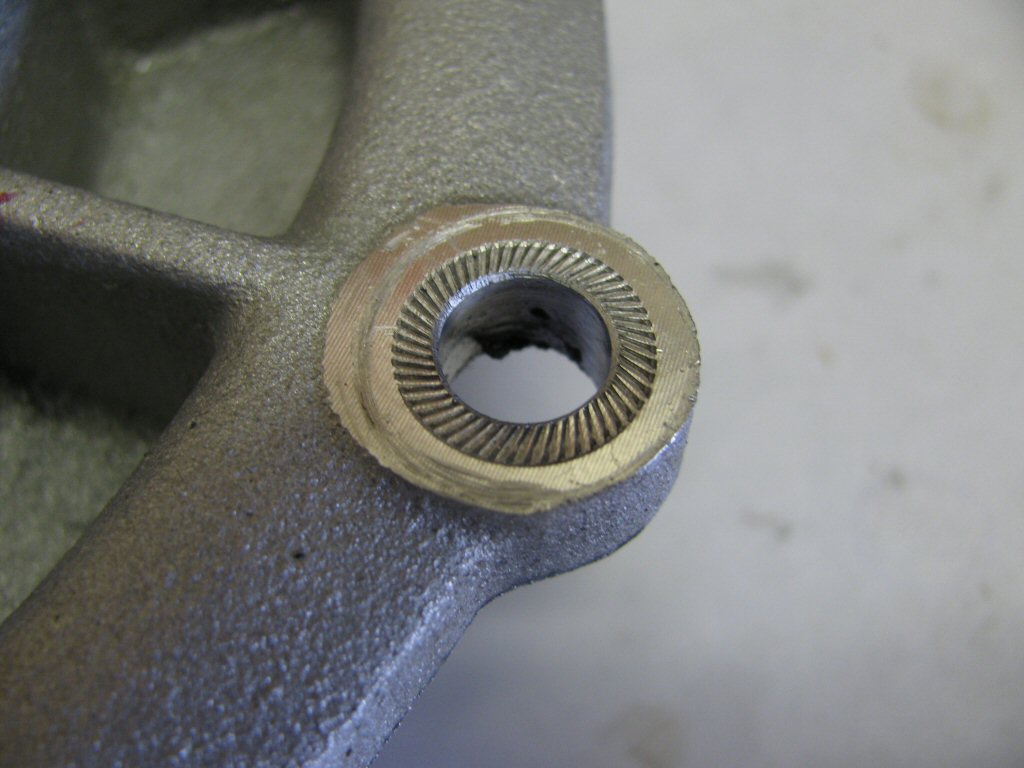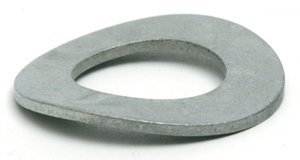Schnorr locking washers - where not to use (and where to use)
Moto Guzzi V700, V7 Special, Ambassador, 850 GT, 850 GT California, Eldorado, and 850 California Police models
It is no secret that I'm not a fan of the original bendy tabs
that Moto Guzzi used to prevent many bolts from coming loose. It isn't that bendy tabs aren't effective, but rather they are inconvenient to work with. For that reason, I've been using Schnorr washers in their place.

Photo courtesy of McMaster-Carr.
Indeed, Moto Guzzi has moved to using Schnorr washers on some fasteners with many of the more modern machines they have produced.
Unfortunately, I extended the use of Schnorr washers to locations where they should not be used.
Specifically, I used Schnorr washers to secure a brand new rear main bearing flange to the crankcase in my Ambassador. That was 15,000 miles ago. Two weeks ago when I rode home from the Phoenix MGNOC monthly Sunday morning breakfast, I discovered a trail of oil running out my driveway, down the street, and out my subdivision. Ug. Fortunately, the engine did not run out of oil. When we returned home from church, I pulled the Ambassador apart to see what had happened. I discovered that six of the eight bolts that secure the rear main bearing flange to the crankcase were loose. The only two bolts that were still tight were the bottom two bolts to which I had applied ThreeBond 1184 semidrying liquid gasket to prevent oil leaks.
How did the other six bolts magically
loosen? I know that used a block and a mallet to ensure the flange was fully seated against the block. I know that I used a torque wrench to properly torque each bolt to spec.
I bit of investigating quickly revealed the problem. The rear main bearing flange is made of aluminum. The Schnorr washers are - by design - quite thin. As I torqued the bolts to spec, the Schnorr washers became embedded within the aluminum of the rear main bearing flange. As they became embedded, the spring pressure of the washer was dramatically reduced. Eventually, with time and vibration, the bolts began backing out. The end result was oil being forced past the gasket into the bellhousing.
In short, I had applied the use of Schnorr washers to an inappropriate application.
If you take a look at the photo, you will clearly see a couple of things (all of the bolt holes were like this). First, the indentation from the Schnorr washers is clearly visible. Second, you can see a circular mark surrounding the Schnorr washer. This mark is from where the bolt came into contact with the flange and rotated. Clearly, the Schnorr washers embedded themselves deep enough into the aluminum that there was no longer sufficient pressure to prevent the bolts from loosening.

Schnorr washer embedded into the aluminum material of the rear main bearing flange on my 1971 Moto Guzzi Ambassador.
Photo courtesy of Gregory Bender.
I did a bit more research into what Moto Guzzi is doing with the modern models they are producing:
- Guzzi uses Schnorr washers (and nothing else) to secure the flange on the rear drive case (they may
glue
that gasket on now???). - Guzzi uses thick wave washers (MG# 03270300) to secure the rear main bearing flange to the crankcase.
- Guzzi uses thick wave washers (MG# 03270300) to secure the front main bearing flange to the crankcase.
So, what did I do? I found some thick wave washers in my stash and secured my rear main bearing flange with them. I also applied a dab of ThreeBond 1184 semidrying liquid gasket to each of the bolts (hey, it can't hurt). I'll be using wave washers from now on in this application.

Photo courtesy of Fastenal.
Source for thick wave washers:
What about Schnorr washers? I'll continue to use them, but only when sandwiched between two steel pieces (as when securing the flywheel to the crankshaft or the ring gear to the flywheel).
By the way, I always use the original type fasteners when securing the connecting rod caps to the connecting rods. That is, if Moto Guzzi originally used the bendy tabs in that locations (as on V700 and Ambassador models), then I use bendy tabs in that location.
Alright, this is way too much information on a tiny subject. Unfortunately I've found it to be important. You can bet I'll be doing things a bit differently moving forward :>